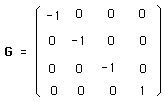Geometrical definition of antimatter.
Observatoire de Marseille
Abstract :
...Through a new four components non-connex group, acting on a ten dimensional space, composed by (x,y,z,t) plus six additional dimensions we give a description of particles like photon, proton, neutron, electrons, neutrinos ( e, m and t ) and their anti, through the coadjoint action on the momentum space. Quantum numbers become components of the moments. Matter and antimatter are interpreted as two different movements of mass-points in this
matter movement taking place in the {z
i > 0} half space and antimatter in the
remnant {z i
< 0} one.
The z-Symmetry :
which there goes with charge conjugation, becomes the definition of matter-antimatter duality.
1) Introduction.
...As pointed out by J.M.Souriau in his book [1] the Poincaré group, as a dynamic group for physics, arises a problem about the sign of the mass.
Everything starts from the Lorentz group L, whose element L is axiomaticaly defined by :
(1)
where :
(2)

The Lorentz group acts on space-time :
(3)

through the action :
(4)
The matrix G comes from the expression of the Lorentz
metric (with c=1) :
(5)
We know than the Lorentz group is composed by four components :
Ln is the neutral componant, which contains the neutral element 1, i.e. the peculiar matrix :
(6)

Ls , the second component, contains the matrix :
(7)

which reverses space.
Lt , the third component, contains the matrix :
(8)

which reverses time.
Lst , the fourth component, contains the matrix :
(9)

which reverses both space and time.
From the Lorentz group one builds the Poincaré group Gp, whose element is :
(10)

C is a space-time translation :
(11)

...If we use the four components
of the complete Lorentz group L , (10) will be called the complete Poincaré
group. As the Lotentz group, it owns four components :
- Its neutral component :
(12) (4212) 
built with the neutral component Ln of the Lorentz group L.
- A second component :
(13)

built with the component Ls of the Lorentz group.
